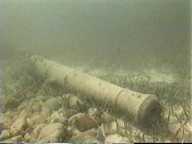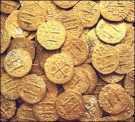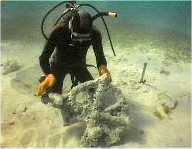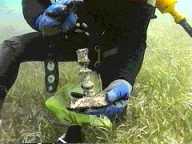Florida
Shipwrecks and Treasures
Over the last
400 years, many ships have used Florida's coastal
waters. Explorers and settlers arrived in Florida
by ship. Soon, Spain began taking the riches of
the Aztec and Incan empires to Europe. Silver and
gold-laden treasure ships sailed along the Florida
coastline. But many ships were wrecked because of
hurricanes, coastal reefs, shallow shores, and even pirates.
pirates.
Marine salvage (recovery) was very profitable in
Florida by the time it  became
a U.S. territory in 1821. Florida Indians and crews
from Havana often competed for the cargo of wrecked
ships in Florida waters. became
a U.S. territory in 1821. Florida Indians and crews
from Havana often competed for the cargo of wrecked
ships in Florida waters.
In modern times, many of the wrecked vessels have
been discovered. Some are in waters shallow enough
to be explored. Some have yielded treasures for
divers and salvagers. The wrecks tell stories about
Florida's history and importance to shipping.
The Tierra Firme fleet sailed from South America
heading home to Spain. The fleet of 27 ships had
a cargo estimated at more than $250 million, including
silver from Peru and Mexico, gold and emeralds from
Colombia, and pearls from Venezuela. Two ships,
the Atocha and the Santa Margarita, were lost in
the Florida Keys during a hurricane. Three hundred
and eighty lives were lost when the two ships went
down.
In 1985, salvager Mel Fisher found the Atocha
in the Florida Keys. The  Spanish
treasure galleon contained tons of treasure. Mel
Fisher's Treasure Exhibit in Key West showcases
Fisher's search for underwater treasure. Recovered
artifacts and gold pieces are on display. Spanish
treasure galleon contained tons of treasure. Mel
Fisher's Treasure Exhibit in Key West showcases
Fisher's search for underwater treasure. Recovered
artifacts and gold pieces are on display.
The Nuestra Espana fleet was one of the last treasure
fleets to cross the Atlantic Ocean for Spain.
On Friday 13, 1733, the ships left Havana on the
return  voyage.
The fleet consisted of three armed galleons and
eighteen merchant ships filled with tanned hides,
rare spices, precious jewels, silver and gold,
all of which were needed for the economic survival
of Spain. voyage.
The fleet consisted of three armed galleons and
eighteen merchant ships filled with tanned hides,
rare spices, precious jewels, silver and gold,
all of which were needed for the economic survival
of Spain.
The ships were grounded in the Florida Keys during
a hurricane. The remains of the fleet were scattered
over 80 miles throughout the keys. The San Pedro's
remains were burned to the waterline by the Spanish
to prevent looting by pirates. Locations of the
wrecks were charted on an official map. Salvage
work continued for years. When a final calculation
of salvaged materials was made, more gold and
silver had been recovered than had been listed
on the original lists of cargo.
 Professional archaeologists have studied 13 known
shipwrecks from the fleet. A Florida Underwater
Archaeological Preserve is open at the San Pedro
site for divers. The San Pedro is among the most
picturesque of the 1733 wreck sites. She is located
in a white sand pocket surrounded by turtle grass.
Abundant marine life inhabits her grave. A large
pile of ballast stones contains flat, red bricks
from the ship's galley. This site is one of Florida's
oldest artificial reefs, host to a variety of
sea creatures living amidst ballast stones and
coral heads.
Professional archaeologists have studied 13 known
shipwrecks from the fleet. A Florida Underwater
Archaeological Preserve is open at the San Pedro
site for divers. The San Pedro is among the most
picturesque of the 1733 wreck sites. She is located
in a white sand pocket surrounded by turtle grass.
Abundant marine life inhabits her grave. A large
pile of ballast stones contains flat, red bricks
from the ship's galley. This site is one of Florida's
oldest artificial reefs, host to a variety of
sea creatures living amidst ballast stones and
coral heads.
More information on diving
and Florida sports. |
